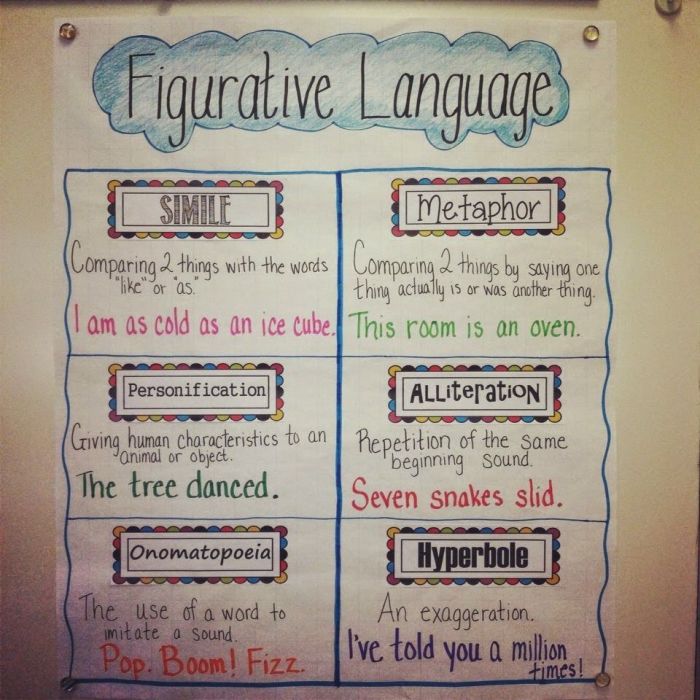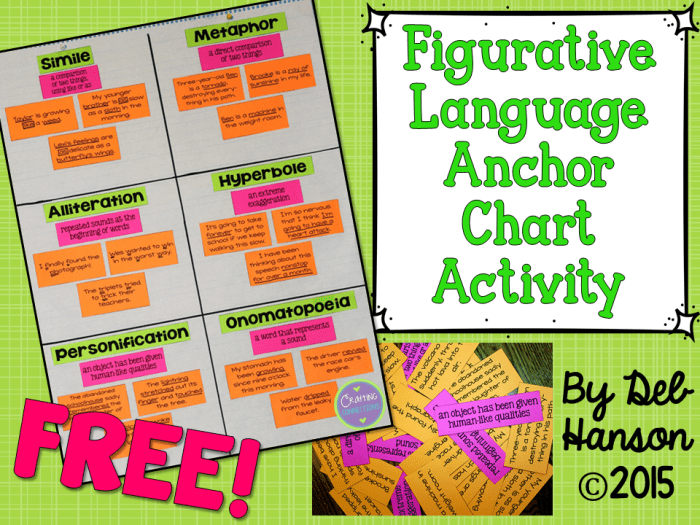Anchor chart for figurative language – Anchor charts for figurative language are an essential tool for teaching students about this important literary device. They provide a visual representation of key concepts and can be used to introduce new concepts, reinforce learning, and assess student understanding.
In this guide, we will explore the benefits of using anchor charts for figurative language, discuss how to create effective anchor charts, and provide ideas for using anchor charts in the classroom.
1. Defining Figurative Language Anchor Charts

Anchor charts for figurative language are visual representations of key concepts and terms related to figurative language. They serve as a valuable resource for students, providing a concise and accessible reference for understanding and applying figurative language techniques.
Anchor charts offer several benefits in teaching figurative language. They:
- Provide a visual and engaging way to present abstract concepts.
- Help students organize and structure their understanding of figurative language.
- Serve as a reference tool for students to review and reinforce their learning.
- Promote active learning and collaboration among students.
Effective anchor charts for figurative language should include clear and concise definitions, relevant examples, and visual representations. They can be created on a variety of materials, such as chart paper, whiteboards, or digital platforms.
2. Creating Anchor Charts for Figurative Language

Creating visually appealing and engaging anchor charts for figurative language requires careful planning and organization. Consider the following strategies:
- Use clear and concise language.The text on the anchor chart should be easy for students to understand and follow.
- Incorporate visual elements.Images, diagrams, and other visual aids can help students visualize and understand the concepts.
- Organize the information logically.The anchor chart should be structured in a way that makes it easy for students to find the information they need.
- Use a variety of colors and fonts.This can help to make the anchor chart more visually appealing and engaging.
- Make the anchor chart interactive.Students can be encouraged to add their own examples and explanations to the anchor chart.
Templates and examples of anchor charts for figurative language can be found online and in educational resources.
3. Using Anchor Charts to Teach Figurative Language: Anchor Chart For Figurative Language
Anchor charts can be used in a variety of ways to teach figurative language. Here are a few ideas:
- Introduce new concepts.Anchor charts can be used to introduce new figurative language concepts to students.
- Provide practice opportunities.Students can use anchor charts to practice identifying and analyzing figurative language.
- Support writing and speaking.Anchor charts can help students to use figurative language in their own writing and speaking.
- Incorporate interactive activities.Anchor charts can be used as a basis for interactive activities, such as games and group discussions.
By incorporating anchor charts into their teaching, educators can help students to develop a deeper understanding and appreciation of figurative language.
4. Assessing Student Learning with Anchor Charts
Anchor charts can be used to assess student learning in a variety of ways. For example, teachers can:
- Use anchor charts as a formative assessment tool.Anchor charts can be used to track student progress and identify areas for improvement.
- Have students create their own anchor charts.This can be a valuable way for students to demonstrate their understanding of figurative language.
- Use anchor charts as a self-assessment tool.Students can use anchor charts to reflect on their own learning and identify areas where they need additional support.
By using anchor charts to assess student learning, educators can gain a better understanding of their students’ strengths and weaknesses.
Clarifying Questions
What are the benefits of using anchor charts for figurative language?
Anchor charts for figurative language can help students to:
- Understand the different types of figurative language
- Identify figurative language in texts
- Interpret the meaning of figurative language
- Use figurative language in their own writing
How do I create an effective anchor chart for figurative language?
When creating an anchor chart for figurative language, it is important to:
- Choose a clear and concise title
- Use visuals to represent the key concepts
- Organize the information in a logical way
- Make the anchor chart visually appealing
How can I use anchor charts for figurative language in the classroom?
Anchor charts for figurative language can be used in a variety of ways in the classroom, including:
- As a teaching tool to introduce new concepts
- As a reference tool for students to use during independent work
- As an assessment tool to track student progress